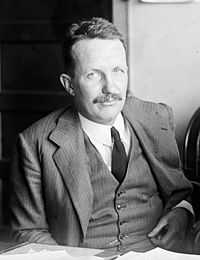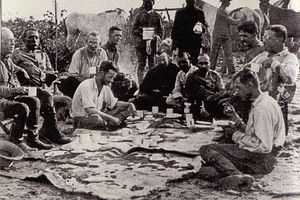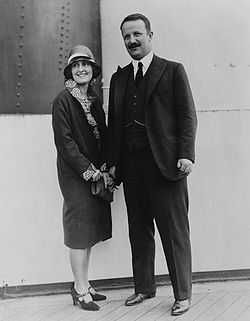Kermit Roosevelt

Kermit Roosevelt MC (October 10, 1889 – June 4, 1943) was a son of U.S. President Theodore Roosevelt. He was an explorer on two continents with his father, a graduate of Harvard University, a soldier serving in two world wars, with both the English and American Armies, a businessman, and a writer. He fought a lifelong battle with depression and alcoholism, and eventually committed suicide.
Childhood

Kermit was born at the family residence Sagamore Hill in Oyster Bay, New York, the second son of Theodore "T.R." Roosevelt, Jr. (1858—1919) and Edith Kermit Carow (1861—1948). He had an elder brother, Theodore "Ted" Roosevelt III (1887—1944), a younger sister, Ethel Carow Roosevelt (1891—1977), and two younger brothers; Archibald Bulloch "Archie" Roosevelt (1894—1979) and Quentin Roosevelt (1897—1918). His older half sister was Alice Lee Roosevelt (1884—1980), from his father's first marriage to Alice Hathaway Lee (1861—1884).
As a child, he had little resistance to illness and infection. He had a flair for language, however, and read avidly. He showed a talent for writing that led to recording his experiences in World War I in a book.

After attending the Groton School, he enrolled at Harvard. In 1909 as a freshman, he and his father (recently out of office as President)—both of whom loved nature and outdoor sports—went on a year long expedition in Africa funded by the Smithsonian Institution. After this trip and a swing through Europe, Roosevelt returned to Harvard and completed four years of study in two and one-half years. He was a member of the Porcellian Club.

River of Doubt South American expedition
One of Theodore Roosevelt's most popular books, Through the Brazilian Wilderness, recounted the father-and-son expedition into the Amazon Basin Brazilian jungle in 1913–14. Father and son went on what would become known as the Roosevelt-Rondon Scientific Expedition, exploring the Brazilian jungle with explorer Colonel Cândido Rondon. During this expedition, they explored the River of Doubt, later renamed Rio Roosevelt in honor of the President, as well as a branch of that river named the Rio Kermit in his honor. The source of the river had been discovered by Rondon earlier, but it had never been fully explored or mapped.
At the time of the expedition, Roosevelt was newly engaged to Belle Wyatt Willard, daughter of the U.S. ambassador to Spain. His mother Edith was concerned about her husband's health and the difficulties of a new expedition, and asked Kermit to accompany his father. He did so, reluctantly delaying his marriage.

The scope of the expedition expanded beyond the original plans, leaving the participants inadequately prepared for a trip tracing the River of Doubt from its source through hundreds of kilometers of uncharted rainforest. The climate and terrain, inadequate gear and food, and two deaths (one drowning, the other murder) turned a scientific expedition into an ordeal. Roosevelt's father contracted malaria and a serious infection resulting from a minor leg wound, weakening him to the point that he considered taking a fatal dose of morphine rather than being a burden to his companions. Roosevelt told his father that he was bringing him back literally "dead or alive" and if he died, he would be an even bigger burden to the expedition. Although Roosevelt contracted malaria as well, he downplayed his sickness to save quinine for his father, nearly dying himself before the physician insisted on giving him the medication by injection. Roosevelt's determination, and his rope and canoe-handling skills were instrumental in saving his father's life. Nonetheless, his father would be plagued by flareups of malaria and inflammation so severe that they would require hospitalization.[1]
Besides the newly named Rio Roosevelt, one branch of the river was named the Rio Kermit in his honor. Today, the Rio Roosevelt is commonly called the Rio Teodoro by Portuguese-speaking Brazilians because of pronunciation difficulties they have with the name 'Roosevelt'.

Although Kermit and TR faced skepticism about their claims of navigating a completely uncharted river over 1000 km long, they eventually silenced their critics through the elder Roosevelt's oratory and one of his most popular books, Through the Brazilian Wilderness. The 1913–14 expedition would later be recounted in The River of Doubt by Candice Millard (Doubleday 2005).
Marriage and Children

After the Amazon trip, in 1914 Kermit married Belle Wyatt Willard (1892–1968), daughter of the U.S. Ambassador to Spain. They had four children:
- Kermit Roosevelt, Jr. (1916–2000) was the mastermind of the Central Intelligence Agency's (CIA) Operation Ajax, which orchestrated the coup against Iran's democratically-elected Mohammed Mossadegh administration, and returned Mohammad Reza Pahlavi, the Shah of Iran, to Iran's Peacock Throne in August 1953 for the purpose of returning Western control of Middle Eastern oil supplies.[2][3]
- Joseph Willard Roosevelt (1918–2008) was a pianist and composer.
- Belle Wyatt "Clochette" Roosevelt (1919–1985)
- Dirck Roosevelt (1925–1953)
From 1914 to 1916, Kermit was assistant manager for National City Bank in Buenos Aires.
Military service in World War I

In 1917 as he was about to be transferred to a Russian branch, the U.S. entered the World War. On 22 August 1917, Roosevelt was appointed an honorary captain in the British Army,[4] and saw hard fighting in the Near East, later transferring to the United States Army. While his other brothers had had summer training at Plattsburg, New York, Roosevelt had missed out on this training.
Roosevelt joined the British Army to fight in the Mesopotamia (modern-day Iraq) theater of World War I. He was attached to the 14th Light Armoured Motor Battery of the Machine Gun Corps, but the British High Command decided they could not risk his life and so they made him an officer in charge of transport (Ford Model T cars). Within months of being posted to Mesopotamia, he mastered spoken as well as written Arabic and was often relied upon as a translator with the locals. He was awarded a Military Cross on 26 August 1918.[5] When the United States joined the war, Roosevelt was transferred to the AEF in Europe, relinquishing his British commission on 28 April 1918.[6] In 1918, he learned that his youngest brother Quentin, a pilot, had been shot down over France and had been buried by the Germans with full military honors.
Between the wars
After the expedition, Roosevelt went into business; he founded the Roosevelt Steamship Company and the United States Lines. He continued to enjoy outdoor activities with his brothers.
In 1925 Roosevelt accompanied his brother Ted on a hunting expedition across the Himalayas - over uncharted mountain passes rising from the Vale of Kashmir through the ancient Silk Route into China - in search of the legendary big-horn wild sheep called Ovis Poli. He documented the trip in his book East of the Sun and West of the Moon. Several trophies collected during this expedition are on display in the Field Museum of Natural History in Chicago.
Service in World War II
By October 14, 1939, when Britain was at war with Germany, Roosevelt had negotiated a commission as a Second Lieutenant in the Middlesex Regiment with the assistance of his friend, Winston Churchill, who was by then First Lord of the Admiralty.[7][8] His first task was to lead a contingent of British volunteers for the Winter War in Finland.[9] According to a contemporary story published in Picture Post, he had resigned from the British Army to lead the expedition.[10] However, before the expedition could be launched, Finland made peace with Russia. Roosevelt served with distinction in a raid into Norway and was later sent to North Africa, where there was little action at the time.[9] He resumed drinking and was debilitated by an enlarged liver complicated by a resurgence of malaria. At the end of 1940, he returned to England and was discharged from the army on health grounds on May 2, 1941, by which time he had once again reached the rank of captain.[9][11] Roosevelt appealed this discharge all the way to the British Prime Minister, Winston Churchill, who upheld the medical discharge.[citation needed]
When he returned to the US, he turned to drinking to forget his problems. His wife enlisted the help of his cousin, President Franklin Delano, who ordered the FBI to track him down, and he was brought back to his family. To extricate him from his current situation, the President gave him a commission as a major in the United States Army, and had him transferred and posted to Fort Richardson, Alaska, where he worked as an intelligence officer and helped establish a territorial militia of Eskimos and Aleuts.
Battle with depression and alcoholism
Kermit's paternal grandmother Martha "Mittie" Bulloch had exhibited signs of bipolar disorder. His paternal uncle, Elliott Bulloch Roosevelt, was afflicted with chronic bouts of depression and died of alcoholism and drug abuse. His maternal grandfather Charles Carow, meanwhile, had been an alcoholic. Alcoholism plagued Kermit much of his adult life.
While there were some similarities between Kermit and his Uncle Elliot throughout both their lives, Kermit's dreamy nature was often covered up by an unyielding drive when presented with a task or goal, such as his efforts during the descent of the River of Doubt. Kermit's situation worsened when he learned of his father's death while overseas.
Death
In Alaska, Roosevelt committed suicide on June 4, 1943, by a self-inflicted gunshot.[12] He was discovered in his house with a gunshot wound in the head by Dr. Sanford Couch Monroe who later filed the autopsy report. His death was reported to his mother Edith, of whom he was the favorite son, as a heart attack. Given the sensitive nature of his death, for many years the cause of death continued to be described as heart disease. Only in later years did the true circumstances of his death become known. He was interred in Fort Richardson National Cemetery near Anchorage, where a memorial stone gateway was erected in his honor in 1949.
He was survived by his wife Belle and four children: Kermit "Kim" Roosevelt, Jr., Joseph Willard Roosevelt, Belle Wyatt Roosevelt, and Dirck Roosevelt.
The town of Kermit, Texas, was named for him (he had visited Winkler County, Texas, a few months earlier to hunt antelope). The town of Kermit, West Virginia, is also named after him.
The Luzon-class repair ship USS Kermit Roosevelt (ARG-16) was named in his honor.
In fiction
Kermit Roosevelt appears as a minor character in the Wilbur Smith novel Assegai on safari in East Africa with his father.
Works
- War in the Garden of Eden: memoirs from World War I
- The Happy Hunting Grounds
- Trailing the Giant Panda (with Theodore Roosevelt, Jr.)
- Quentin Roosevelt: A Sketch with Letters
- The Boy Scout's Book of True Adventure, Fourteen Honorary Scouts, with Foreword By Theodore Roosevelt and Biographical Notes By James E. West. Published by G. P. Putnam's Sons, New York (1931) – Essays include: "Adventurous Hunting" by Kermit Roosevelt, "Scouting Against the Apache" by Frederick R. Burnham, "How I Learned to Fly" by Orville Wright, "An Arctic Mirage" by Donald B. MacMillan, "In the Arctic" by Lincoln Ellsworth, "A Tobacco Trade" by George Bird Grinnell, "The Black Ghosts of the Tana River" by James L. Clark, "My Flight Over the Atlantic" by Richard Evelyn Byrd, "In the Jungles of Cochin-China" by Theodore Roosevelt, "Shipwreck" by Robert A. Bartlett, "Written in the Air" by Charles Lindbergh, "Tiger! Tiger!" by Merian C. Cooper, "The First Crossing of the Polar Sea" by Lincoln Ellsworth, "Bandits" by Clifford H. Pope, and "Adventure" by Stewart Edward White. All 13 photo plates of the honorary Scouts are present; both Roosevelts in the same photo.
- "East of the Sun and West of the Moon" (with Theodore Roosevelt, Jr.)
See also
Notes
- ↑ Thayer, Chapter XXIII, pp. 4–7.
- ↑ "Confessions of an Economic Hitman," by John Perkins, 2004.
- ↑ "All The Shah's Men – An American Coup And The Roots of Middle East Terror," by Stephen Kinzer, 2008.
- ↑ The London Gazette: (Supplement) no. 30304. p. 9925. 25 September 1917. Retrieved 2008-09-02.
- ↑ The London Gazette: (Supplement) no. 30865. p. 9966. 23 August 1918. Retrieved 2008-09-02.
- ↑ The London Gazette: (Supplement) no. 30656. p. 5128. 26 April 1918. Retrieved 2008-09-02.
- ↑ Renehan 1998. p229
- ↑ The London Gazette: (Supplement) no. 34709. pp. 6938–6939. 13 October 1939. Retrieved 2008-09-02.
- ↑ 9.0 9.1 9.2 Renehan 1998. p230
- ↑ Unattributed (16 March 1940). "Volunteers For Finland". Picture Post.
- ↑ The London Gazette: no. 35153. p. 2576. 2 May 1941. Retrieved 2008-09-02.
- ↑ Renehan 1998. p232
References
- The River of Doubt by Candice Millard (Doubleday 2005), ISBN 978-0-7679-1373-7
- The Lions Pride: Theodore Roosevelt and His Family in Peace and War. Oxford University Press. 1998. ISBN 0-19-513424-9.
External links
| Wikimedia Commons has media related to Kermit Roosevelt. |
| Wikisource has the text of a 1921 Collier's Encyclopedia article about Kermit Roosevelt. |
- Works by Kermit Roosevelt at Project Gutenberg
- Almanac of Theodore Roosevelt: Kermit Roosevelt
- NNDB Who's Who
- Family Photos
- Theodore Roosevelt Association
- "Kermit Roosevelt". Find a Grave. Retrieved 2008-02-08.
- Jaguar rug from South American expedition, Kansas Historical Society collections
|
